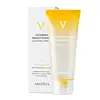What's inside
What's inside
 Key Ingredients
Key Ingredients

 Benefits
Benefits

 Concerns
Concerns

 Ingredients Side-by-side
Ingredients Side-by-side

Water
Skin ConditioningButylene Glycol
HumectantGlycerin
HumectantNiacinamide
SmoothingCeramide AP
Skin Conditioning1,2-Hexanediol
Skin ConditioningAmmonium Acryloyldimethyltaurate/Vp Copolymer
PEG-7 Glyceryl Cocoate
EmulsifyingCarbomer
Emulsion StabilisingTromethamine
BufferingChlorphenesin
AntimicrobialAdenosine
Skin ConditioningDisodium EDTA
Tocopheryl Acetate
AntioxidantEthylhexylglycerin
Skin ConditioningCamellia Japonica Flower Extract
EmollientActinidia Chinensis Fruit Extract
EmollientAnanas Sativus Fruit Extract
Skin ConditioningFragaria Vesca Fruit Extract
AstringentHoney Extract
HumectantOpuntia Ficus-Indica Stem Extract
Skin ConditioningPropolis Extract
Skin ConditioningPrunus Persica Fruit Extract
AbrasivePyrus Malus Fruit Extract
Skin ConditioningVitis Vinifera Fruit Extract
Skin ConditioningWater, Butylene Glycol, Glycerin, Niacinamide, Ceramide AP, 1,2-Hexanediol, Ammonium Acryloyldimethyltaurate/Vp Copolymer, PEG-7 Glyceryl Cocoate, Carbomer, Tromethamine, Chlorphenesin, Adenosine, Disodium EDTA, Tocopheryl Acetate, Ethylhexylglycerin, Camellia Japonica Flower Extract, Actinidia Chinensis Fruit Extract, Ananas Sativus Fruit Extract, Fragaria Vesca Fruit Extract, Honey Extract, Opuntia Ficus-Indica Stem Extract, Propolis Extract, Prunus Persica Fruit Extract, Pyrus Malus Fruit Extract, Vitis Vinifera Fruit Extract
Water
Skin ConditioningButylene Glycol
HumectantGlycerin
HumectantTrehalose
HumectantMethyl Trimethicone
Skin Conditioning1,2-Hexanediol
Skin ConditioningSqualane
EmollientPhenyl Trimethicone
Skin ConditioningPCA Dimethicone
Skin ConditioningCaprylyl Methicone
Skin ConditioningAmmonium Acryloyldimethyltaurate/Vp Copolymer
Lactobacillus Ferment Lysate
Skin ConditioningCarbomer
Emulsion StabilisingPropanediol
SolventTromethamine
BufferingAcrylates/C10-30 Alkyl Acrylate Crosspolymer
Emulsion StabilisingGlyceryl Caprylate
EmollientEthylhexylglycerin
Skin ConditioningDisodium EDTA
Raffinose
Skin ConditioningStearyl Behenate
EmollientMalachite Extract
AntioxidantParfum
MaskingPolyglyceryl-3 Methylglucose Distearate
EmulsifyingInulin Lauryl Carbamate
Emulsion StabilisingTranexamic Acid
AstringentTryptophan
MaskingHydroxypropyl Bispalmitamide Mea
EmollientBeta-Glucan
Skin ConditioningLimonene
PerfumingAcorus Gramineus Extract
HumectantLinalool
PerfumingTocopherol
AntioxidantWater, Butylene Glycol, Glycerin, Trehalose, Methyl Trimethicone, 1,2-Hexanediol, Squalane, Phenyl Trimethicone, PCA Dimethicone, Caprylyl Methicone, Ammonium Acryloyldimethyltaurate/Vp Copolymer, Lactobacillus Ferment Lysate, Carbomer, Propanediol, Tromethamine, Acrylates/C10-30 Alkyl Acrylate Crosspolymer, Glyceryl Caprylate, Ethylhexylglycerin, Disodium EDTA, Raffinose, Stearyl Behenate, Malachite Extract, Parfum, Polyglyceryl-3 Methylglucose Distearate, Inulin Lauryl Carbamate, Tranexamic Acid, Tryptophan, Hydroxypropyl Bispalmitamide Mea, Beta-Glucan, Limonene, Acorus Gramineus Extract, Linalool, Tocopherol
 Reviews
Reviews

Ingredients Explained
These ingredients are found in both products.
Ingredients higher up in an ingredient list are typically present in a larger amount.
1,2-Hexanediol is a synthetic liquid and another multi-functional powerhouse.
It is a:
- Humectant, drawing moisture into the skin
- Emollient, helping to soften skin
- Solvent, dispersing and stabilizing formulas
- Preservative booster, enhancing the antimicrobial activity of other preservatives
Ammonium Acryloyldimethyltaurate/Vp Copolymer (let's call it AAVC for short) is a synthetically created polymer. It's used as a film-forming agent and used to thicken the consistency of products.
AAVC is able to increase the consistency and viscosity of products due to its large molecule size. It also prevents ingredients from separating.
Butylene Glycol (or BG) is used within cosmetic products for a few different reasons:
Overall, Butylene Glycol is a safe and well-rounded ingredient that works well with other ingredients.
Though this ingredient works well with most skin types, some people with sensitive skin may experience a reaction such as allergic rashes, closed comedones, or itchiness.
Learn more about Butylene GlycolCarbomer is a polymer of acrylic acid. Its main role is to create a gel consistency.
A high amount of carbomer can cause pilling or balling up of products. Don't worry, most products contain 1% or less of carbomer.
Disodium EDTA plays a role in making products more stable by aiding other preservatives.
It is a chelating agent, meaning it neutralizes metal ions that may be found in a product.
Disodium EDTA is a salt of edetic acid and is found to be safe in cosmetic ingredients.
Learn more about Disodium EDTAEthylhexylglycerin (we can't pronounce this either) is commonly used as a preservative and skin softener. It is derived from glyceryl.
You might see Ethylhexylglycerin often paired with other preservatives such as phenoxyethanol. Ethylhexylglycerin has been found to increase the effectiveness of these other preservatives.
Glycerin is already naturally found in your skin. It helps moisturize and protect your skin.
A study from 2016 found glycerin to be more effective as a humectant than AHAs and hyaluronic acid.
As a humectant, it helps the skin stay hydrated by pulling moisture to your skin. The low molecular weight of glycerin allows it to pull moisture into the deeper layers of your skin.
Hydrated skin improves your skin barrier; Your skin barrier helps protect against irritants and bacteria.
Glycerin has also been found to have antimicrobial and antiviral properties. Due to these properties, glycerin is often used in wound and burn treatments.
In cosmetics, glycerin is usually derived from plants such as soybean or palm. However, it can also be sourced from animals, such as tallow or animal fat.
This ingredient is organic, colorless, odorless, and non-toxic.
Glycerin is the name for this ingredient in American English. British English uses Glycerol/Glycerine.
Learn more about GlycerinTromethamine helps balance the pH and improve the texture of a product. It is synthetically created.
As an emulsifier, Tromethamine prevents oil and water ingredients from separating. This helps stabilize the product and elongate a product's shelf life. Tromethamine also makes a product thicker.
Tromethamine helps balance the pH level of a product. Normal pH level of skin is slightly acidic (~4.75-5.5). The acidity of our skin is maintained by our glands and skin biome. Being slightly acidic allows our skin to create an "acid mantle". This acid mantle is a thin barrier that protects our skin from bacteria and contaminants.
Oral Tromethanmine is an anti-inflammatory drug but plays the role of masking, adding fragrance, and/or balancing pH in skincare.
1,3-Propanediol, 2-amino-2-(hydroxymethyl)-
Learn more about TromethamineWater. It's the most common cosmetic ingredient of all. You'll usually see it at the top of ingredient lists, meaning that it makes up the largest part of the product.
So why is it so popular? Water most often acts as a solvent - this means that it helps dissolve other ingredients into the formulation.
You'll also recognize water as that liquid we all need to stay alive. If you see this, drink a glass of water. Stay hydrated!
Learn more about Water